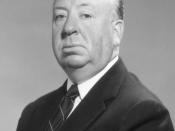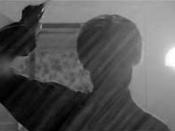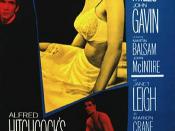Alfred Hitchcock?s Psycho has paved the way as one of the most influential films of its time. Hitchcock?s artistry in his lighting, objective/subjective camera shots, and camera angles allows us to enjoy the voyeuristic point of views of the characters in Psycho. Through specific scenes I will show the sequence of shots that shows the voyeurism in Psycho.
The opening shot begins by shooting across many skyscraper buildings and at random chooses to go down and infiltrate into a window in a hotel building. There, the camera pauses at the half-open window that has the blind slightly open, leaving an orifice for us to voyeuristically intrude into the dreary room. As the camera takes a moment to adjust to the dark interior of the room we see a bedroom with a semi-nude couple. We see a beautiful woman (Marion Crane), wearing only a white bra and slip and reclining back on a bed, and is with her shirtless lover (Sam Loomis) who stands over her.
In the background we see a bathroom, which is the first of three, which basically emphasizes the shower scene. We watch Sam and Marion kiss and caress each other still showing us voyeurism.
In a different scene we see Marion have moment of weakness and impulse, she has been tempted to bring the money home to her small bedroom instead of to the bank. Again we see Marion half naked wearing only a black bra and slip. Marion continually and in trepidation eyes the money in a envelope lying on the bed The camera zooms in and cuts back and forth to the envelope more than once. Next to it is her packed suitcase, ready for a trip. Behind her we see her bathroom with the showerhead predominantly noticeable.
In the scene where Marion is startled by the cop we see some more specific camera shots that show the voyeuristic features of Psycho. When the cop asks to check her driver's license the camera shot is from a low camera angle facing back from the passenger's seat, she turns her back to him and goes into her purse while the officer is leaning on the window behind her and watching her. Marion removes the envelope from her purse and nervously places the money between her body and the automobile seat, and then took her papers out. He checks the license and registration and lets her drive away, but follows her for a while before getting off. The audience identify with Marion?s dilemma through subjective camera movements.
The shower scene where Marion goes to her cabin to take a shower we see Norman in the parlor listening to the wall for sounds. Then, he removes one of the nude paintings from a clasp, revealing a rough hole chipped out of the wall with a bright peephole in its center. We see Norman leaning down to peeping at Marion through the hole. The camera angle shifts and from Norman's point of view, he sees her undress down to her black bra and slip in front of her open bathroom door, a subjective camera shot which gives us the same peeping voyeurism that Norman is enjoying. Than the camera shows us a massive close-up of his large eye, which fills the screen giving us the audience the objective point of view of Norman watching Marion take off her undergarments and become naked. The camera shot goes back to Marion putting on a robe and walking out of Norman?s as well as ours. This is the most voyeuristic scene, as well as, the scene that lets the audience identify with the masculine sexual position of the spectator Norman.
Finally we get to the last scene when Norman is in a holding room. Norman is sitting still in a daze. We listen to the voice of mother in Norman?s head while the camera slowly zooms in on Norman?s face. The subjective camera shot implicates the voyeuristic view of the police and the audience that are watching him through the peephole of the door.
As I emphasized before, we the audience are sexually positioned through the eyes of the masculine spectator. It is evidently shown in the shower scene when we acquire Norman?s point of view. Most of the voyeuristic camera shots are of Marion in her undergarments, in the opening scene in the hotel, in her bedroom when she had stolen the money, and of course the shower scene. Hitchcock?s artistry of camera shots, not the concept of the story is why this film set an example for future movies using voyeurism.





